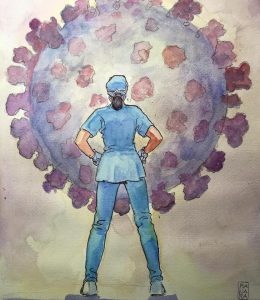
Reinventing the value equation
pharmafile | April 27, 2020 | Feature | Business Services, Manufacturing and Production, Medical Communications, Research and Development, Sales and Marketing | Drug pricing, feature, real world data, real world evidence, real-world data, real-world evidence
There is a duty to ensure access to innovative treatments for patients with unmet need, but a health service gatekeeper must commit to efficient use of limited resources. Matt Fellows looks at how real-world evidence could be the key to reassessing how we determine the value of these drugs and ensure their swift availability.
Medical innovation has historically been the key ingredient to some of our greatest strides in fighting disease and ill health, but the truth is that these kinds of breakthroughs don’t come cheap. As long as there are hours of manpower and millions, sometimes billions of dollars being invested in pursuit of pushing the envelope of science and public health, there will always be justification for the high costs that so often come with best-in-class treatment.
The drug pricing debate is inextricably at the core of medicines research and development, and understandably inspires much passion and devoted reasoning on either side of the aisle. A drug developer must recoup their hefty investment to generate a safe, effective, and globally compliant product in order to ensure future innovation and keep the industry cycle turning, but if this cost exceeds the price feasibly payable by patients or healthcare services, then access and uptake become an issue.
To reach the rigorous quality benchmark set by global regulators, developers turn to the faithful randomised controlled trial (RCT). The parameters of RCTs allow researchers to evaluate a potential candidate in carefully controlled conditions, but while they are the gold standard for evidence generation for regulatory review, watchdogs for socialised healthcare programmes – such as the UK’s NICE is to the NHS – must frequently pass on approvals because holes in the data mean that an accurate valuation of the product cannot be reached.
When this happens, decision-makers reviewing the product for routine use on a health service cannot properly assess whether or not they are a cost-effective use of often finite resources. This ultimately means that patients in need are locked out of access to these products.
Recommendations are given to developers to fill these gaps in the data, who then often have to conduct further costly and time-consuming clinical trials, further delaying access for patients in need. Surely this is not the most efficient way forward when time and resources are at a premium and patient lives are on the line?
As negotiations over pricing bring drug makers into conflict with these agencies and criticism rises from patients and advocacy bodies, it is no wonder why real-world evidence is gaining such traction throughout the industry. Its potential for bolstering the efficacy and safety profiles of potentially lifesaving treatments by venturing into existing data banks, such as electronic medical records or insurance documentation, also promises cost-savings and speedier access for patients.
This view is one of the core forces behind the regulatory work done by the Medicines and Healthcare product Regulatory Agency (MHRA) in the UK. When quizzed on how real-world data slots alongside other considered forms of evidence in its decision to approve a drug for use, a spokesperson for the agency told [Pharmafocus]:
“When assessing quality, safety and efficacy for a drug licence, the MHRA will review any data that a Company submits, and this could include submitting RWE as part of a marketing authorisation application. Real world data (RWD) can take different forms. If the design of the RWD-based study is appropriate to address the scientific question being considered, and the data source is of an appropriate standard, then RWE can form an important part of a submission.
“The MHRA’s mission is to protect public health. While considering cost is not part of this remit, the agency recognises that reducing the cost and duration of development programmes, while maintaining the quality of evidence produced, provides benefits for public health. We believe that in some regulatory situations increased use of RWE could achieve this. One particular example is the repurposing of existing drugs for new indications, where in some contexts randomised trials could be conducted using RWD sources instead of using traditional controlled clinical trial approaches.”
The estimation of RWE in the eyes of the industry has only continued to rise as these benefits have become more apparent and sources of real-world data have proliferated, and this is key to keeping pace with an ever-evolving technology landscape. The valuation of a drug becomes much more complicated in the case of novel, one-time treatments that have emerged over the past few years like gene therapies. These new interventions can reach infamously high prices: Novartis’ CAR T leukaemia therapy Kymriah made headlines for its initial $475,000 price tag, and this was eclipsed later by Spark Therapeutics’ rare blindness drug Luxturna, which launched at a whopping cost of $425,000 per eye.
To accurately model the benefit/risk of such products, especially when they have often only presented efficacy data drawn from comparatively small groups of patients, can prove exceptionally challenging, meaning that the majority of patients may never access their ground-breaking and transformative benefits. However, if real-world evidence could be used to prove that such a huge upfront investment could actually generate cost savings further down the line – such as by eliminating the need for costly repeat hospital visits or cancer surgery – then it may be beneficial for the service to commit that initial investment. Such insights are very difficult to generate through RCT data alone, and as such may struggle on the back of this to convince regulatory authorities that their price of admission is a cost-effective endeavour. So where does RWE come in?
“New therapies fall short of approval most often because the MHRA reaches the decision that the data submitted have not demonstrated that the balance of risks and benefits of the treatment is favourable. This will often be because the treatment is truly not beneficial,” the agency spokesperson explained. “However, on some occasions, it may be that additional data could provide the necessary reassurance.
“When specifically considering new therapies, studies based entirely on RWD are generally less feasible than they are for existing treatments, due to the difficulties of giving a largely untested substance in a real-world setting. There are however possibilities where RWD can be used to generate a control arm to compare to data generated on the new treatment in a traditional clinical trial setting. The appropriateness of this would need to be considered on a case-by-case basis. Even if a trial producing RWE is not possible in a particular clinical setting, RWD sources such as routine clinical records can still be used improve trial efficiency, for example by identifying patients who could be recruited into trials. In addition, RWD may offer solutions for post-authorisation data generation, such as clinical effectiveness pragmatic trials where outstanding issues regarding how the drug works in clinical practice can be assessed in the real-world patient populations.”
Where’s the balance?
Both sources of evidence have their place when it comes to considering a product’s safety and efficacy, and ultimately its value. But where industry and regulators are still, in the grand scheme of things, finding their feet with the utility of RWE, where is the balance to be struck? Are there some situations where existing data in the real world could stand in effectively in place of RCT data?
“In some situations it is possible to imagine RWE substituting for traditional clinical trial data without any lowering of evidential standards, as randomised controlled trials could be run using RWD,” the MHRA spokesperson said. “Considering other scenarios, moving from randomised evidence to, for example, external RWD-based control groups, would lower the level of evidence, but depending on the clinical situation of the population being studied – for example, the rarity of a condition – this could be considered acceptable. RWD can offer a unique view of the safety and effectiveness of a new drug in settings outside of the stricter framework of a clinical trial. RWD might be complementary to clinical trial data and provide different insights into how a drug works.”
Ultimately, when striving for an accurate valuation of a drug, RWE provides a much more complete picture. The sheer heterogeneity of the potential user base of any drug means that we will never fully understand the full breadth of its benefits and risks on feasible timelines through RCTs alone.
In NICE’s ‘Statement of intent’, these are identified as “contextual factors”, and would be crucial in accurately determining the value of a product in particular sub-populations of patients.
The statement reads: “The observed discrepancy between the effects of a health intervention in routine clinical practice (effectiveness) and the effects demonstrated in RCTs (efficacy) is known as the ‘efficacy effectiveness gap’.
“Contextual factors that interact with the effect of an intervention are known as drivers of effectiveness. These factors can contribute to an efficacy effectiveness gap. There are three levels of contextual factors:
• The actual use of the intervention (for example, adherence, co-medication, dose/intensity, duration of use)
• Patient and disease (for example, age, gender, behavioural factors, baseline risk, genetics, severity of disease, comorbidities)
• Healthcare system (for example, implementation, medical practices, screening policies)”
These are factors which, by nature, cannot be evaluated in randomised controlled trials, given their purpose of providing a controlled microcosm of the real-world intent-to-treat population, and these microcosms are not always proportionately representative. This can lead to distorted evaluations of a product’s efficacy, which in turn can skew any potential assessment of its value.
“RCTs may not always reflect these contextual factors, and high-quality observational data may better indicate the expected effectiveness in routine clinical practice,” the statement continues. “For most decisions relevant to NICE guidance, the expectation is that the efficacy measured in well-designed trials will be greater than the effectiveness derived from analysis of broader types of data. This is because in routine practice characteristics such as age, comorbidities and adherence are more likely to reduce the effectiveness of the intervention compared with trial settings than enhance it. Qualitative data sources may also provide useful contextual information, for example by providing detail on any challenges in delivering an intervention or on the experiences of patients.”
Seeking guidance
The benefits that RWE can bring to transforming the value equation in drug access are clear and the wheels are turning on ever-increasing adoption from trial designers and regulators. But what still needs to be done to bring this invaluable data source into the spotlight?
As the MHRA explained, the Academy of Medical Sciences convened a roundtable in 2018 to determine the next steps for the use of RWE in regulatory decision-making. It found that the industry is still looking for external guidance on how best to apply it, and this may prove to be one of the most pressing needs to be addressed in future if we are to fully harness its potential.
“One of the main conclusions was that further guidance is still needed on the acceptability of different types of RWE for different purposes. It was considered that such guidance would stimulate innovation in the field by reducing uncertainty around the acceptance of such study designs. With this in mind, the MHRA is planning to publish guidance on points to consider when designing trials to produce RWE for submissions to the MHRA.”
Matt Fellows
Related Content

US pharma lobby launches legal action against the Trump administration over drug pricing proposals
US industry organisations including the Pharmaceutical Research and Manufacturers of America (PhRMA) have launched legal …

Patient Experience: Living with Timothy syndrome
Thirteen-year-old Calvin Muir lives with the ultra-rare genetic condition Timothy syndrome. Like many parents of …

Oncology research in the age of COVID-19
Matt Fellows investigates the new challenges facing the oncology space and explores the strategies that can …








